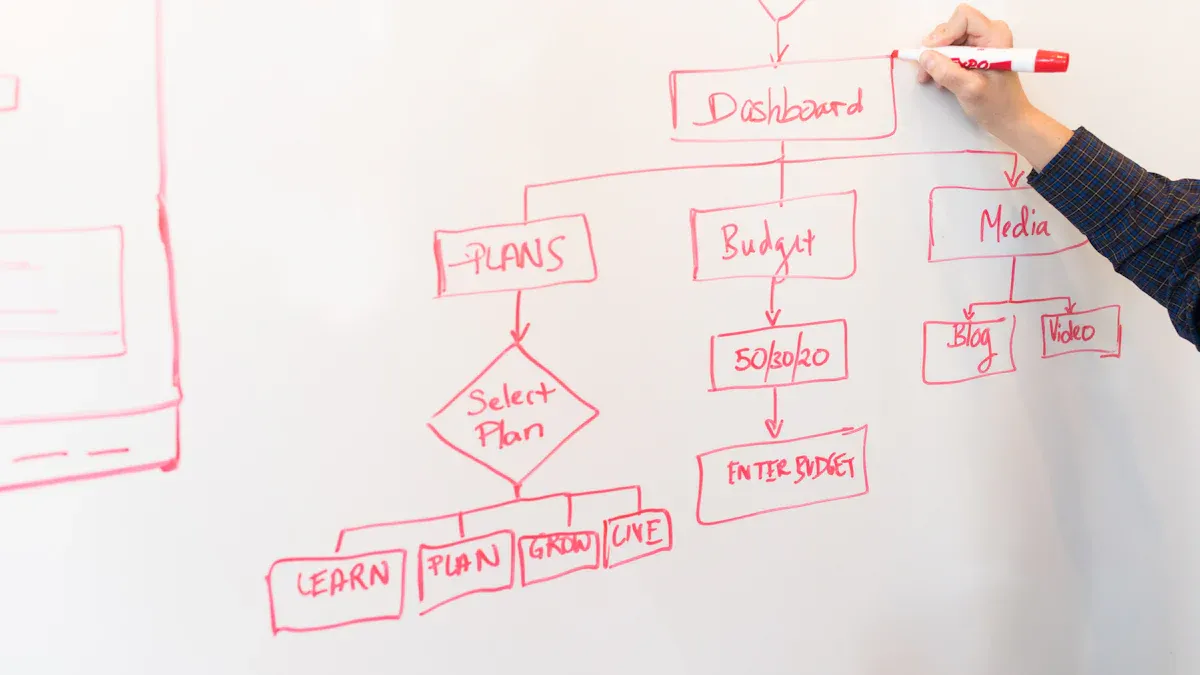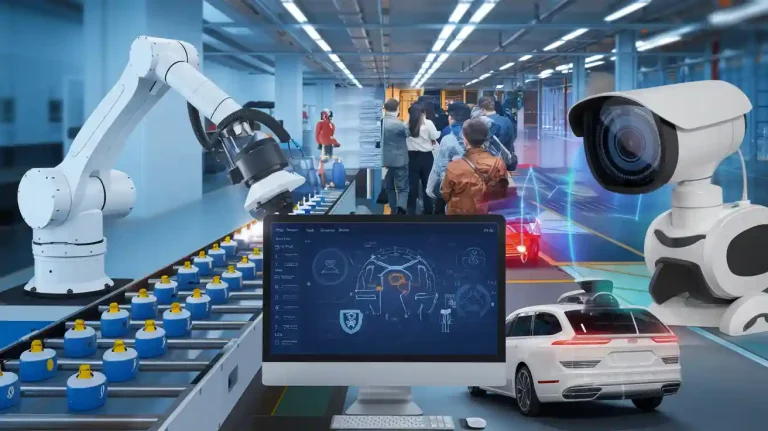ONNX (Open Neural Network Exchange) machine vision systems help unlock true AI interoperability by bridging different frameworks and hardware. Interoperability and model portability matter for modern machine vision because teams need flexibility to deploy models anywhere. Around 42% of AI professionals now use ONNX for this purpose, showing a shift toward open standards. ONNX stands apart from older machine vision standards by supporting cross-platform deployment and optimization. Major companies such as Microsoft and Facebook support ONNX, which helps machine learning practitioners build efficient, flexible solutions.
Key Takeaways
- ONNX enables machine vision models to work across different AI frameworks and hardware, giving developers flexibility and avoiding vendor lock-in.
- Strong industry support from companies like Microsoft, NVIDIA, and Intel ensures ONNX works well on many platforms and devices.
- ONNX simplifies model training, conversion, optimization, and deployment, helping teams build efficient and portable machine vision solutions.
- Using ONNX Runtime boosts inference speed and reduces resource use, making it ideal for real-time and edge device applications.
- Following best practices like using official converters and testing models helps avoid conversion issues and ensures smooth deployment.
ONNX (Open Neural Network Exchange) Machine Vision System
Open Neural Network Exchange Overview
The ONNX (open neural network exchange) machine vision system acts as an open standard for sharing and deploying machine learning models. ONNX supports interoperability across different frameworks, which means developers can train models in one framework and use them in another. This flexibility helps teams avoid vendor lock-in and makes it easier to use the best tools for each task.
Key features of the open neural network exchange standard make it suitable for machine vision applications:
- Interoperability across machine learning frameworks, allowing seamless model sharing.
- Support for many model types, including deep learning models like convolutional neural networks (CNNs), which are important for vision tasks.
- Graph-based model representation that handles complex structures.
- A wide set of operators, such as convolutions and activations, needed for vision.
- ONNX Runtime provides cross-platform support and hardware acceleration, including GPUs and specialized chips.
- Performance optimizations like kernel fusion and quantization boost inference speed.
- An open ecosystem with tools for model conversion, visualization, and optimization.
- Efficient deployment on both edge and cloud, enabling real-time inference.
ONNX libraries help developers convert, optimize, and deploy models. The ONNX Model Zoo offers a collection of pre-trained ONNX models for tasks like image classification, object detection, and segmentation. Popular deep learning models such as ResNet, MobileNet, and Mask-RCNN are available, making it easy to start with proven solutions.
Ecosystem and Industry Support
The ONNX (open neural network exchange) machine vision system has strong support from leading companies and organizations. This broad industry backing ensures that ONNX libraries and ONNX Runtime work well across many platforms and devices. The table below shows some key players and their roles:
| Company | Role/Industry | ONNX Support / Use Case Description |
|---|---|---|
| NVIDIA | AI hardware and software | Uses ONNX Runtime to optimize and deploy machine learning models on NVIDIA GPUs and edge devices. |
| Intel | Hardware and AI acceleration | Supports ONNX Runtime via Intel OpenVINO to accelerate ML inference across Intel hardware. |
| InFarm | Intelligent farming solutions | Runs computer vision models on diverse hardware using ONNX Runtime to standardize model formats and improve deployment. |
| Hypefactors | NLP and Computer Vision applications | Uses ONNX Runtime for scaling NLP and computer vision models with GPU acceleration and quantization tools. |
| Rockchip | Edge AI hardware | Supports ONNX Runtime to deploy ML models on Rockchip NPU-powered devices. |
Many companies use ONNX libraries to deploy deep learning models in real-world machine vision systems. The ONNX (open neural network exchange) machine vision system stands out because it allows shared optimization across frameworks and hardware. This approach helps improve performance and makes it easier to move models between different environments. The open neural network exchange standard continues to grow, with new tools and updates from the community.
Interoperability and Model Portability
Framework and Hardware Flexibility
ONNX stands out in the world of machine vision because it enables true interoperability between deep learning frameworks. Developers can train deep learning models in PyTorch or TensorFlow and then convert them into the ONNX format. This process allows the same model to run in different programming languages, such as Python, JavaScript, or TypeScript, using official runtime modules. ONNX models often have smaller file sizes than TensorFlow models, which makes deployment easier and faster.
ONNX’s graph-based serialization method improves portability across frameworks and languages. This approach works better than binary formats like Pickle or Joblib, which can limit model interoperability. ONNX also provides tools like Netron for model visualization and debugging, making integration smoother.
The table below shows the wide range of frameworks, cloud services, and inference runtimes that support ONNX in machine vision applications:
| Category | Examples |
|---|---|
| Frameworks & Converters | CoreML, Optimum, Keras, NCNN, PaddlePaddle, SciKit Learn |
| Cloud Services | Azure Cognitive Services, Azure Machine Learning |
| Inference Runtimes | deepC, Optimum |
This broad support means teams can deploy machine learning models on many types of hardware, from cloud servers to edge devices. ONNX Runtime, OpenVINO, and TensorRT help optimize model execution on CPUs, GPUs, and specialized chips. This flexibility and interoperability make ONNX a strong choice for machine vision projects that need to run on different platforms.
Seamless Integration in Machine Vision
ONNX makes it easier to integrate deep learning models into existing machine vision pipelines. Teams can convert models from frameworks like PyTorch or TensorFlow into ONNX format using tools such as torch.onnx.export or tf2onnx. After conversion, ONNX models can run on various hardware using runtimes like ONNX Runtime, NVIDIA TensorRT, or OpenVINO. This process supports real-time performance in industrial automation, edge computing, and other vision applications.
ONNX reduces vendor lock-in by allowing developers to move models between frameworks and hardware without retraining. This model portability saves time and resources. Teams can reuse machine learning models across different projects and environments, which increases flexibility and speeds up deployment.
- ONNX supports official runtime modules for multiple languages, making integration smooth in Python, JavaScript, and TypeScript.
- PyTorch models need to be exported to ONNX for use in JavaScript or TypeScript, while TensorFlow models require retraining and exporting with special modules for web use.
- ONNX’s flexibility and portability make it a preferred choice for latency-sensitive or cross-language machine vision applications.
ONNX also helps optimize models for resource-constrained environments. Quantization techniques reduce model size and improve inference speed, which is important for edge devices. Teams can address compatibility challenges by adapting custom layers during conversion and keeping ONNX versions up to date.
ONNX provides a technical foundation for integrating machine learning models into vision systems with optimized performance and broad hardware support. This foundation supports ai interoperability and model portability, which are key for modern machine vision.
ONNX’s approach to interoperability and model portability gives developers more control and freedom. They can choose the best tools and hardware for each task, which leads to better results and faster innovation in machine vision.
Workflow

Model Training and Export
A typical ONNX workflow for machine vision starts with model training. Developers often use popular frameworks like PyTorch or TensorFlow to train models for tasks such as image classification or object detection. After training, they export and import models to ONNX format. For PyTorch, the torch.onnx.export function converts the trained model. TensorFlow users rely on the tf2onnx conversion tool. Setting the ONNX opset version to 15 ensures compatibility with most inference engines. This process standardizes model conversion and prepares models for deployment across different platforms. The ONNX Model Zoo provides pre-trained models, which help teams start quickly without building models from scratch.
import torch
model = torch.load('model.pt')
input_data = torch.randn(1, 3, 224, 224)
output_path = 'model.onnx'
torch.onnx.export(model, input_data, output_path, verbose=True)
Conversion and Optimization
Model conversion plays a key role in the ONNX workflow. Developers use conversion tools like Ultralytics YOLO and OnnxSlim to simplify and optimize models. These tools remove unnecessary operations and streamline the architecture. Quantization reduces the numerical precision of models, making them smaller and faster for edge deployment. Pruning and clustering further reduce model size and speed up inference. Knowledge distillation transfers information from large models to smaller ones, which helps when deploying on devices with limited resources. Hyperparameter tuning improves both speed and accuracy. ONNX Runtime supports these optimizations, making conversion and deployment efficient.
- Ultralytics YOLO library: Direct export and optimization for ONNX models.
- OnnxSlim: Model slimming for faster loading and inference.
- ONNX Runtime: Hardware acceleration for CPUs, GPUs, and edge devices.
Deployment in Machine Vision
Model deployment becomes straightforward with ONNX Runtime. This engine accelerates models by using hardware-specific optimizations. It supports CPUs, GPUs, and specialized chips, allowing flexible deployment. ONNX Runtime serializes models for parallel execution, reducing size and improving speed. Execution Providers in ONNX Runtime enable hardware-accelerated inference, which lowers latency and increases throughput. Developers can deploy models on cloud servers, edge devices, or even web browsers. ONNX Runtime removes framework-specific dependencies, making model deployment portable and efficient. The ONNX Model Zoo offers ready-to-use models for fast deployment in real-world machine vision systems.
ONNX Runtime gives developers the tools to optimize, convert, and deploy models across many platforms, supporting efficient and flexible machine vision solutions.
Inference Performance
Speed and Efficiency Gains
ONNX delivers high performance in machine vision by improving inference speed and reducing resource use. Many developers see faster results when they use ONNX Runtime for real-time tasks. The table below compares ONNX Runtime and PyTorch for single-image inference:
| Framework | Batch Size | Inference Time (ms) | Notes |
|---|---|---|---|
| ONNX Runtime | 1 | 24.17 | Faster initial inference, optimized for low latency |
| PyTorch | 1 | 30.39 | Slower initial inference |
| PyTorch | 32, 128 | Comparable or slightly faster than ONNX | Better for large batches due to memory optimizations |
ONNX Runtime achieves about 20% faster initial inference speed than PyTorch at batch size 1. This advantage helps in low-latency machine vision tasks, such as real-time object detection. ONNX also reduces CPU usage during inference. In one test, CPU utilization dropped from 47% to 0.5% without increasing latency. This efficiency is important for high performance in edge devices and embedded systems.
ONNX models often run up to five times faster than PyTorch in long tests. Conversion to ONNX can shrink model size, which lowers memory needs and speeds up deployment. Many users report 1.5 times faster inference after converting to ONNX, showing clear gains in model performance.
ONNX supports high performance by combining fast inference, low resource use, and easy deployment across platforms.
Hardware Acceleration
ONNX Runtime supports many hardware accelerators to boost high performance in machine vision. These accelerators include NVIDIA CUDA and TensorRT, Intel OpenVINO, AMD ROCm, Qualcomm QNN, Apple CoreML, Android NNAPI, and Windows DirectML. ONNX Runtime can split the model graph to use these accelerators, which improves inference performance on different devices.
- NVIDIA CUDA and TensorRT help ONNX models run fast on GPUs.
- Intel OpenVINO and oneDNN support high performance on Intel CPUs and VPUs.
- Apple CoreML and Android NNAPI allow deployment on mobile devices.
- Qualcomm QNN and AMD ROCm add support for more hardware options.
This wide support lets teams deploy ONNX models on cloud servers, desktops, and edge devices. ONNX makes high performance possible on many platforms, giving developers more choices for deployment.
Challenges and Best Practices
Conversion Issues
Many developers face challenges when converting machine vision models to ONNX format. Crashes and performance differences often appear between the original and converted models. About 59% of practitioners report these problems. Incompatibility issues, such as type mismatches, can stop the conversion process. Sometimes, the converted model gives different predictions than the original. Unsupported layers, like Fourier layers, may not convert at all. Driver problems can also occur during deployment on user machines. Mapping between graphs with different operators and semantics adds more complexity. Most defects happen during the node conversion stage.
- Crashes or performance drops after conversion
- Type mismatches and unsupported data types
- Prediction changes between original and converted models
- Unsupported layers or custom operators
- Driver or hardware issues during deployment
- Complex graph structures causing conversion failures
Developers often seek help from community forums or official documentation. Testing the converted model for correctness is important. Changing ONNX versions sometimes solves compatibility issues. Each conversion evaluation should include a check for behavioral consistency.
Compatibility Tips
Teams can follow several best practices to improve ONNX adoption in machine vision projects:
- Use official converters like torch.onnx for PyTorch or tf2onnx for TensorFlow. These tools map framework operators to ONNX operators correctly.
- Avoid custom operators when possible. Custom layers can cause compatibility problems across frameworks.
- Stick to the standard ONNX operator set. This helps maintain interoperability and reduces errors.
- Pay attention to ONNX versioning. Matching opset numbers between models and runtimes prevents version conflicts.
- Use tools like Netron to visualize the ONNX computational graph. This helps verify the model structure.
- Serialize models with Protocol Buffers. This step keeps forward and backward compatibility.
- Deploy models with ONNX Runtime. This runtime supports CPUs, GPUs, and accelerators, making deployment flexible.
- Use ONNX Runtime’s graph optimization and operator fusion to boost inference speed.
Handling hardware and application differences is also important. Edge devices may have different hardware, so teams should use hardware-agnostic systems. When models have dynamic shapes, dynamic axis annotations help maintain flexibility. For resource-limited devices, model compression, quantization, and pruning can improve performance.
Community resources and forums offer valuable support for troubleshooting conversion and compatibility issues. Regular testing and validation help ensure reliable deployment and maintain interoperability.
ONNX unlocks AI interoperability and model portability for machine vision systems. Teams benefit from a standardized format that supports deployment across CPUs, GPUs, FPGAs, and edge devices.
- ONNX enables optimization and quantization, reducing model size for efficient use on resource-constrained hardware.
- The ONNX Model Zoo provides pre-trained models, saving time and resources.
- ONNX Runtime supports hardware acceleration and multiple programming languages, making integration flexible.
Many organizations report improved performance and flexibility. Developers can explore ONNX to streamline future machine vision deployments.
FAQ
What is ONNX and why does it matter for machine vision?
ONNX stands for Open Neural Network Exchange. It lets teams use models across different AI frameworks and hardware. This helps developers save time and makes machine vision projects more flexible.
Can ONNX models run on edge devices?
Yes, ONNX models can run on edge devices. ONNX Runtime supports CPUs, GPUs, and special chips. Teams can use quantization and optimization to make models smaller and faster for edge deployment.
How do developers convert models to ONNX format?
Developers use tools like torch.onnx.export for PyTorch or tf2onnx for TensorFlow. These tools help export trained models into ONNX format. The process usually takes a few steps and works for many popular model types.
What should teams do if a model fails to convert to ONNX?
Teams should check for unsupported layers or operators. They can update the ONNX version or use community forums for help. Sometimes, changing the model or using a different converter solves the problem.
See Also
How Artificial Intelligence Is Changing Industrial Machine Vision
New Opportunities In Machine Vision Through Synthetic Data
Machine Vision Technology Shaping The Future Of Assembly Verification
Neural Network Frameworks Driving Innovation In Machine Vision
Enhancing Machine Vision Systems Using Advanced Deep Learning









